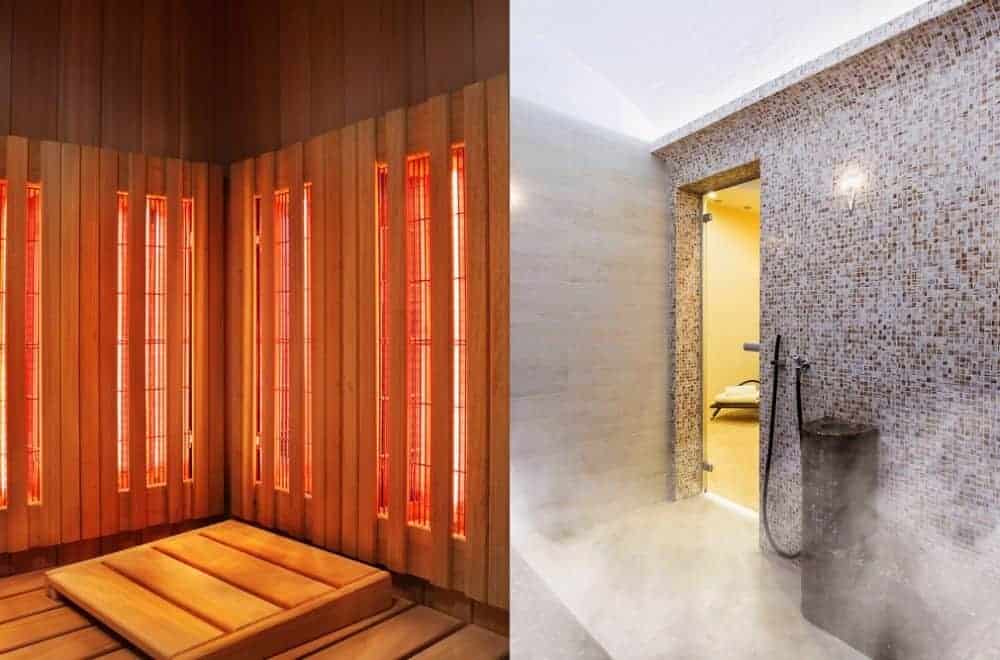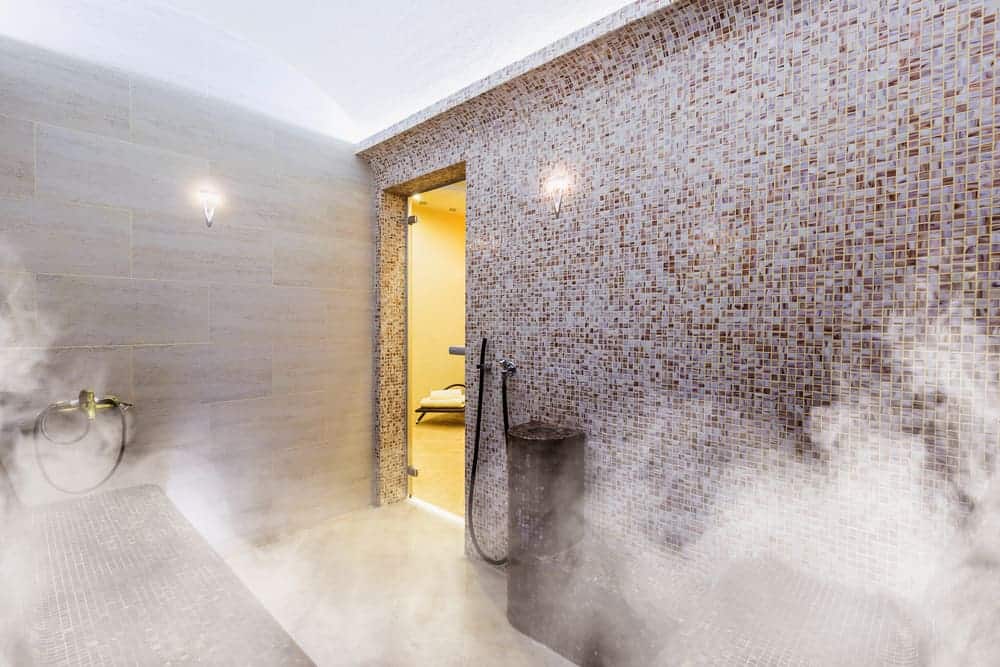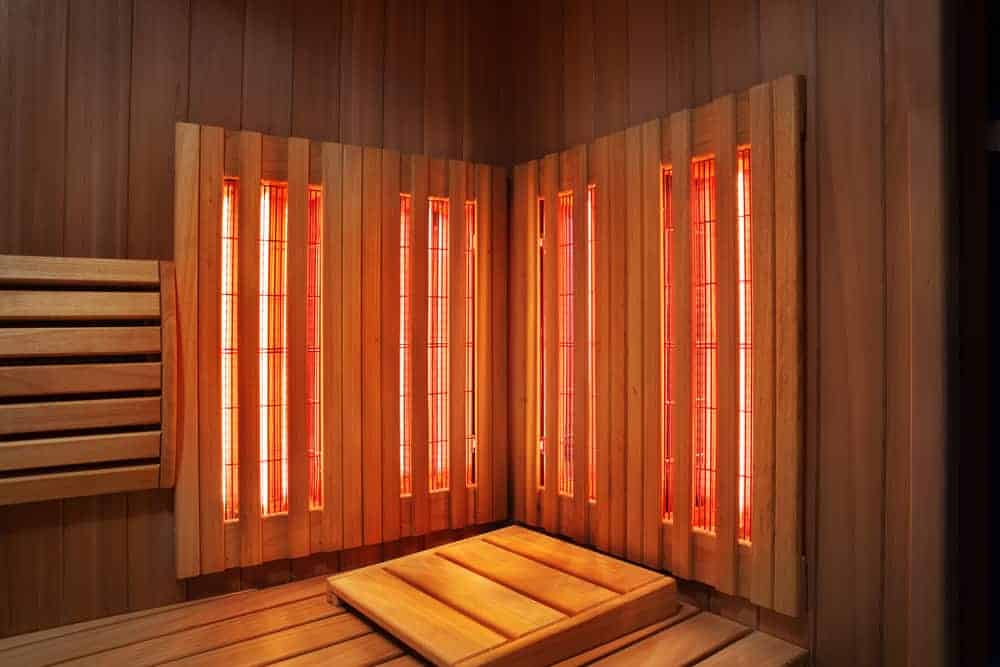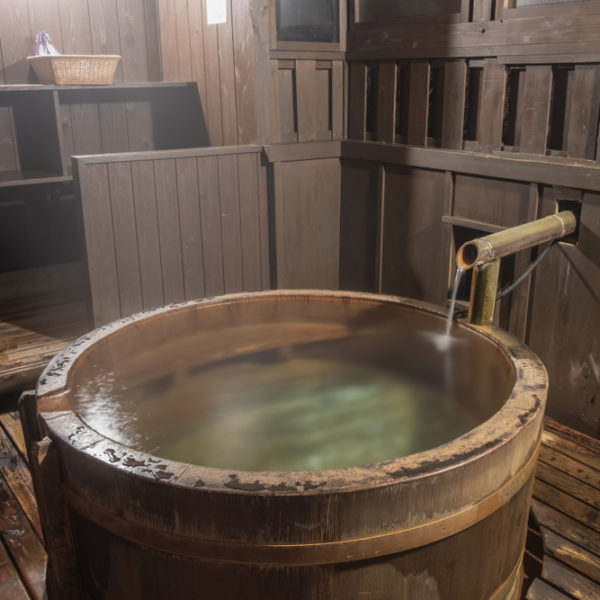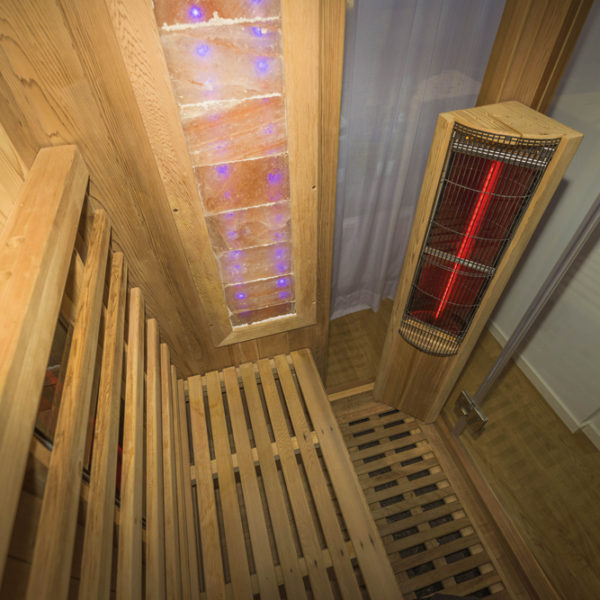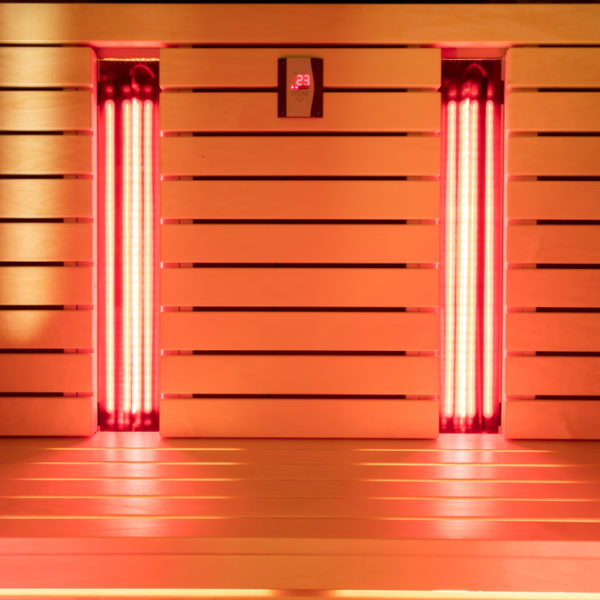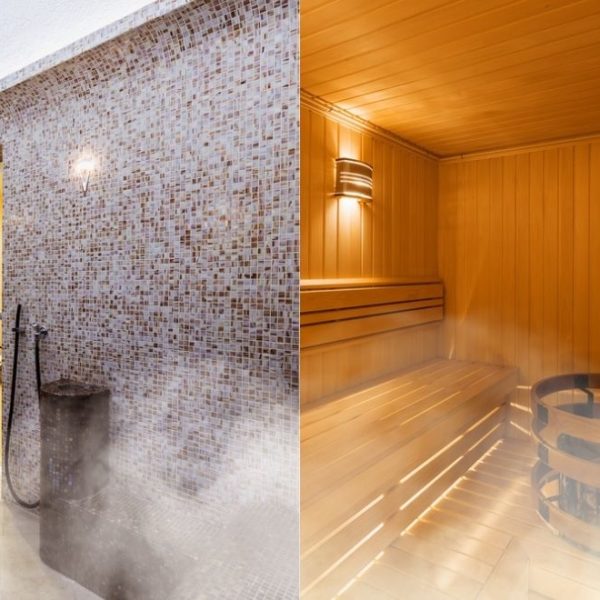Many people who want to indulge in sauna sessions have doubts about the unit they need to purchase. Should you go for a steam room or an infrared sauna? What are the most significant benefits of each, and which one is better?
Discerning the slight differences between steam and infrared saunas is a challenging venture for the layman’s eye. Both types impact your body in different ways due to their unique heating methods.
Hence, it’s vital to grasp the perks and mechanics of steam and infrared saunas to understand how they compare. Let’s find out which alternative best suits your needs.
What Is A Steam Sauna?
In traditional steam rooms, people used to sit in log cabins with fire pits in the middle to warm themselves. They would lay rocks over the fire and throw water to create steam. For centuries, people believed that heated and humid air combined produce numerous health benefits.
Today, traditional saunas comprise almost the same segments. Contemporary steam rooms are airtight and made of non-porous materials, such as tiles or plastic. However, they use glass-confined premises and vapor generators to avoid throwing water on rocks and heat the environment.
However, unlike infrared saunas, which create dry heat, steam rooms generate moist heat. Their structure also varies from small tents in individual homes to luxury-tiled rooms in spas and gyms.
What Is An Infrared Sauna?
Infrared sauna units are wood-based premises that heat and penetrate the body with infrared rays. These wooden cabins are an advanced version of traditional saunas. Since infrared saunas come equipped with infrared heaters or lamps, they skip the humidity segment and focus on heat.
As no vapor is present, IR rays warm the body without increasing the overall room temperature. Moreover, you can choose between a near and far infrared sauna unit. The first emits rays that penetrate and heal the skin, while the second produces rays that reach the deeper tissues.
Steam Vs. Infrared Sauna: What’s the Difference?
At first glance, steam and infrared saunas look alike. Yet, several aspects differentiate between how both options heal and relax your body. More so, the heating methods of traditional and advanced alternatives differ, so procurement and running costs are not the same.
Once you learn what benefits each option offers, you can weigh up the ups and downs and decide that’s best for you. Below is an ultimate list of all differences between infrared and steam saunas and why each aspect matters.
1. Mechanics
The heating methods of steam and infrared saunas are far from similar. Steam saunas use an electric heater with rocks to raise the air temperature and then the user. You sit in the room and heat the stones by pouring water over them to create vapor.
The rationale behind steam units is that they operate by heating the surrounding air until your body starts to cool down naturally. As a result, your blood comes to the skin surface and pores open to let sweat go.
As opposed, infrared saunas generate rays that penetrate the body without producing heat in the environment. IR has unique properties, which allow the air temperature to remain bearable, as with sauna blankets. Plus, infrared light absorption lets the body cool down without involving any vapor.
2. Health Benefits
Saunas have been the postulate of alternative medicine for ages when it comes to relaxation and therapeutic purposes. If you want to buy a sauna to relax, meditate, reduce stress, and detoxify, both sauna options will do the job.
Still, thanks to IR technology, infrared saunas can deliver more measurable health benefits. The advanced heaters heat the body directly, and this boosts your thermal energy. Besides the profound sweat at lower temperatures, infrared saunas have anti-aging and mental health benefits, too.
Other perks of IR units include improved circulation and reduced blood pressure. You will also experience muscle and joint relief and possibly, water and weight loss. On top of that, research has shown positive effects on wrinkle smoothening, skin detox, and acne treatment.
3. Temperature
Both infrared and hot rock saunas involve tolerable heat levels. Steam rooms reach air temperatures ranging from 110 to 120 degrees Fahrenheit to induce sweat. Similarly, the indoor air temperature of infrared saunas sits at about 120 to 140 degrees Fahrenheit.
Often, users find the IR environment more bearable and get to stay longer in the chamber. IR units remain cooler since they heat the body directly and not through the room. As a result, infrared rays induce intense sweating as opposed to the way steam saunas operate.
Since steam rooms use hot vapor to heat you, the environment feels way sultrier than it is. Yet, the temperature needn’t be as high as that of traditional saunas. Though users sweat at an accelerated rate, their bodies are not getting much heat.
4. Humidity
As for humidity, steam saunas are the absolute winner with a level of 100%. Supporters claim that the humidity aspect is what brings so many benefits to the user. Besides opening pores and nasal passages, the heavy steam can promote rehydration and deep sleep.
Infrared saunas skip the steam aspect and thus involve no humidity. You get a dry heat experience and use the sweating component to gain health benefits. IR sauna proponents claim to find the profuse sweating much more enjoyable since they cannot stand the wet feeling of the air.
4. Cost
The price you’ll pay for a sauna unit will come down to the type you select. Sauna size, materials quality, extra equipment, and features will also impact the ultimate cost. Once you measure all properties, you can decide whether you’re getting any value for your money.
The lower-end prices of infrared saunas are about $2,000, while high-quality units range from $3,700 to $10,000. Premium models can be even heftier, particularly if you’re buying a 4-6 person unit.
As for steam saunas, a pre-assembled kit for an indoor sauna will cost you $4,200. The most common modular steam rooms bear a price tag of up to $6,000. On the high end, you can find a six-person sauna with custom-built properties, which can cost $10,000 or more.
In addition, we’ll take a closer look at the running costs for each sauna type. Your monthly bills will depend on how often you use the chamber, the local rate per kWh, and the heater kilowatt rating.
Generally, infrared saunas are energy-efficient since they heat up quickly before use. So, if you use the unit three times a week, you’ll pay about $15 per month on electricity. Note that idle saunas don’t add up to the cost.
Conversely, using a steam sauna three times per week for an hour can cost up to $30 a month. The calculation assumes you have a 6kW heater in both cases.
5. Installation
Investing in a home sauna is a wise step. Both indoor and outdoor saunas add value to real estate. Alternatively, if the unit is mobile, you can choose to take it along whenever you move. The same is valid for sauna blankets.
When comparing infrared and steam saunas, the first one is easier to install. Besides being lighter to transport, IR units require less effort and skills. More so, they come pre-built with a manual on assembling it by yourself.
On average, two people will need an hour to two and a few hand tools to set up a self-installed sauna kit. When ready, you can plug the unit into an electrical outlet and start sweating. Overall, infrared saunas can save you a lot on installation costs.
For a steam sauna, you’ll need a professional or contractor to build the chamber. However, some manufacturers sell pre-built steam sauna kits you can set up on your own.
Moreover, steam saunas have specific ventilation, electrical, and plumbing requirements. Plus, steam rooms require an airtight space and sloped ceilings to ensure moisture prevention. You need an adequate drainage system, too.
6. Energy Requirements
When installing a sauna unit in your home, it’s of the utmost importance to consider the applicable energy requirements. In short, traditional steam saunas require more energy since they heat water to its boiling point. As a result, they can consume nearly 6 kW per session.
In turn, infrared saunas use energy to run the heating elements only. They spend about 1.6 kW or a third of the power consumed by steam saunas per session. Hence, the electricity needed to run a regular sauna makes infrared options less expensive from a power perspective.
7. Maintenance
Most saunas require low maintenance, so besides running costs, your overall expense will remain low. However, sauna owners need to consider a few other aspects that can burden your budget over the sauna lifespan. Extra expenditure includes service visits, replacement parts and elements, and cleaning.
The cheaper the unit you bought, the less pricey its replacement elements will be. Still, poor-quality saunas may be prone to more frequent repairs and failure. Also, pre-built kits are easier to maintain and don’t require a professional to replace parts, particularly infrared lamps.
As for cleaning, IR saunas give off dry heat, so the moisture level is super low and comes down to your perspiration only. Lack of moisture means no mold and mildew, and thus a cleaner environment.
Conversely, steam saunas are damp and hence, the ideal breeding place for mold. In this case, you need to spend more time and money to clean the unit and ensure proper hygiene at all times. We suggest you use towels to prevent sweat stains on benches and germs accumulation.
8. Safe Use
Extreme sweating requires frequent water intake during sauna exposure, especially if you’re using a sauna blanket. It’s also vital to time your sessions well and take short breaks in between to avoid overheating and dehydration.
Preliminary studies show that infrared saunas aren’t a health threat but must get used in moderation. An average session shouldn’t exceed 20 minutes and not more than a few times per week. Avoid intense sweating if you feel tired, unwell, or dizzy.
9. The Experience
Finally, infrared and steam saunas differ in how you experience the whole thing. Steam saunas are moist and sticky spaces, which makes them ideal for 20-minute bursts.
As opposed, IR saunas emit a dry, non-humid, and comfortable heat that doesn’t bother users. Go for it if you prefer a more intense and therapeutic sweat followed by detox at lower temperatures. As a result, users can relax for prolonged periods and get multiple health benefits.
What Sauna Is The Right For Me?
Both steam and infrared saunas have a positive impact on stress relief, detox, and weight loss. Depending on your preferences and lifestyle, you can decide which sauna will fit your future goals best. We recommend you try both alternatives and see which one you indulge in more.
Also, when deciding which option will suit your needs, it’s crucial to carry out thorough research. Compensating quality for low cost may not always be a wise step. If you can’t afford an all-inclusive kit at the moment, go for a sauna blanket to get the ball rolling.
Indeed, some of you will prefer the calm, softer nature of the infrared sauna. Others will enjoy the sensory experience of steam saunas full of vapor, heat, and smell. Our final verdict is that whatever sauna unit you choose, you’ll experience tremendous mental and physical benefits.
Bottom Line
If you doubt whether an infrared or steam sauna is the way to go, you can always refer to this comparison article. Regardless of the type you opt for, sauna exposure will help you relax and strengthen your health.
What’s your experience with saunas? Do you prefer the steam room, or would you rather sweat in a dry infrared sauna? Please, share your thoughts in the comments below and keep checking our site for more practical insight.
